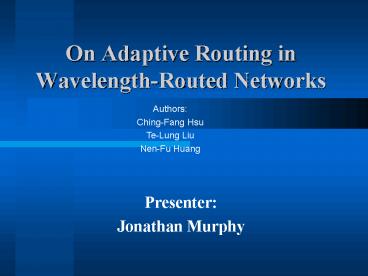Presenter: PowerPoint PPT Presentation
Title: Presenter:
1
On Adaptive Routing in Wavelength-Routed Networks
Authors Ching-Fang Hsu Te-Lung Liu Nen-Fu Huang
- Presenter
- Jonathan Murphy
2
Overview
- Background Information
- Adaptive Routing Algorithms
- Analytical Model
- Numerical Results
- Conclusion
3
Background Information
- Alternate Routing
- Predefined set of paths assigned for each s-d
pair - If ever s-d pair has only one path, its fixed
routing - Adaptive Routing
- Routing path dynamically determined based on
present state of network
4
Background Information
- Assumption All wavelength routers have full
wavelength conversion capabilities - Therefore, wavelength assignment is not
discussed, only routing - Adaptive routing is focus for this paper
5
Adaptive Routing Algorithms
- Shortest Path Strategy (SP)
- Objective is to minimize
- Link cost
- Wavelength conversion cost
Wavelength conversion cost
Link Cost
6
Adaptive Routing Algorithms
- Shortest Path Strategy (SP)
- Advantage
- Minimizes use of resources
- Disadvantage
- Does not balance link utilization
- One link may be overburdened while another is not
used at all
7
Adaptive Routing Algorithms
- Least-Loaded Path Strategy (LLP)
- Objective is to balance link utilization
- F(ei) Number of free wavelengths
- For each possible path, find the link with the
fewest number of free wavelengths - Select the Path with the largest value
Maximize
8
Adaptive Routing Algorithms
- Least-Loaded Path Strategy (LLP)
- Advantages
- Balances link utilization across the network
- Disadvantages
- May lengthen connection paths
- Wasted bandwidth
- Higher blocking rate
9
Adaptive Routing Algorithms
- Weighted-Shortest Path Strategy (WSP)
- Focus of this paper
- Tries to balance utilization without cost of
increased resource usage or blockage - Hybrid method of above to strategies
- Minimize value of BPsd X CPsd
- BPsd Busy Factor
- CPsd Cost of links on path from s to d
10
Adaptive Routing Algorithms
- Goal Minimize value of BPsd X CPsd
- BPsd Busy Factor
- CPsd Cost of links on path from s to d
11
Analytical Model
- Exploits single-link model
- Analysis of blocking probability
- Extended to develop blocking performance of
Weighted-Shortest Path Model - Also uses overflow model
- Used to obtain set of non-linear mathematical
equations - Final stage
- Use successive substitution in iterative fashion
for final solution
12
Analytical Model
- Assumptions
- Every node is a full wavelength router
- All connection calls request circuit connections
- Arrival of connection requests is Poisson process
with individual arrival rates. - Assume wavelength conversion cost zero
13
Analytical Model
- Begin with the distribution of the number of free
wavelengths on a single link - Can be done because of Poisson process of
connection requests - From here can find the blocking probability of a
link - Now, Find the distribution of the number of free
wavelength channels on a single path - Use and create a recursion function based on
single link information above
14
Analytical Model
- Find the traffic load of a specific route
- Use a cost function
- Use this to determine probability that cost of
current link is less than all other links - Find network-wide blocking probability
- Calculate blocking probability of specific route
- Use this to find network-wide block probability
equation, P - Finally, use successive substitution of all above
formulas to evaluate P
15
Numerical Results
16
Numerical Results
- Compares the three strategies (as well as the
analytical model performance for blocking) - Compares across the 3 network topologies as well
17
Numerical Results
Available of wavelengths
- Blocking probability (W4)
Logarithmic Scale
Number of connection requests per unit connection
holding time
18
Numerical Results
- Blocking probability (W4)
19
Numerical Results
- Blocking probability (W4)
20
Numerical Results
- Blocking probability (W8)
21
Numerical Results
- Blocking probability (W8)
22
Numerical Results
- Blocking probability (W8)
23
Numerical Results
- Blocking probability results
- Blocking probability is higher with increasing
traffic load for all strategies - Both SP and WSP better than LLP
- LLP takes more hops thus uses more bandwidth
- SP and WSP have similar performance
- WSP 12 less than SP when W8 and connections
150 in NSFNET - WSP 16 less for interconnected rings when W8
and connections 50
24
Numerical Results
- Overall WSP is best at higher loads
- Also, results of analytical model within an
acceptable range - Best with mesh network though
25
Numerical Results
- Average Number of Hops (W4)
26
Numerical Results
- Average Number of Hops (W4)
27
Numerical Results
- Average Number of Hops (W4)
28
Numerical Results
- Average Number of Hops (W8)
29
Numerical Results
- Average Number of Hops (W8)
30
Numerical Results
- Average Number of Hops (W8)
31
Numerical Results
- Average of hops results
- LLP taking more hopes very obvious here
- SP and WSP very close
- Notice that average of hops decreases as
connection requests - Blocking probability increases here
- Therefore, networks ability to grant longer
connections (and thus more hops) decreases - Especially true when W4
32
Numerical Results
- Standard Deviation of Link Utilization (W4)
33
Numerical Results
- Standard Deviation of Link Utilization (W4)
34
Numerical Results
- Standard Deviation of Link Utilization (W4)
35
Numerical Results
- Standard Deviation of Link Utilization (W8)
36
Numerical Results
- Standard Deviation of Link Utilization (W8)
37
Numerical Results
- Standard Deviation of Link Utilization (W8)
38
Numerical Results
- Standard Deviation of Link Utilization results
- LLP performs best here!!!
- But at cost previously mentioned
- WSP performs significantly better than SP
39
Conclusion
- Weighted-Shortest Path (WSP) adaptive routing
strategy proposed - Seeks to combine best features of SP and LLP
- Analytical model proposed as well
- Results
- WSP works well
- Analytical model is accurate
- Best with mesh network

